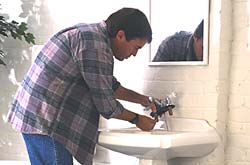Floor and Shower Drains
See if We Have Top-Rated
Plumbing Contractors in Your Area

We all know that any type of drain can get clogged, some more easily than others. Even though they are designed to withstand quite a good amount of abuse, floor and shower drains are, nevertheless, common candidates for clogging problems. Hair and other shower by-products easily get caught in subsurface pipes. Floor drains are prevalent in laundry rooms, garages, and basements where they are frequent receptacles for wastewater from washing machines, air conditioners, and water heaters. These drains are necessary, the waste has to leave your house some way, but when a clog occurs they are also some of the hardest drains to clear.
Shower Drains
Interestingly enough, the first thing you should try when unclogging your shower drain is pouring a hair removal product, Nair, for example, down the drain. Chances are hair is the reason for your clog and there's a good chance this will work. If it becomes a recurring problem, you may need a better shower drain cover to catch more of the hair before it enters your drain. If you don't have a hair removal product in your home, baking soda and vinegar can also work.
If this doesn't work, you may have a more extensive problem. You may need to call a plumber if you don't have the expertise to disassemble the drain. When you take this recourse, you should ask the plumber about the general condition of the shower drain, not just the clog. Newer drain assemblies use a bondable waterproof membrane that can protect your mortar bed from becoming saturated.
Give your bathroom floors a new look! Use this link to
Install Tile
Floor Drains
Floor drains are a different matter altogether. More than just wastewater, lint, sand, and grime can crystallize in your drain causing a real clogging nightmare. When this happens you're way beyond hair removal products and will probably need to either call a plumber or rent a power auger. This machine uses cutting blades to cut through the clog. If you have a drain basin with a clean out plug, you'll be able to circumvent the drain trap and enter directly into the pipe. Otherwise, you'll have to snake the drain through the drain assembly, which increases the difficulty in reaching the clog. Once you reach the clog, the blades are designed to alternate directions as you move back and forth through the clog.
Floor drains are unique in that they are often designed to allow a certain amount of overflow. High amounts of pressure can be created in many floor drains. A standpipe holds back some of the wastewater causing the drain to overflow. This keeps the pipes and drain assembly from breaking. If you think your drain is accepting high levels of wastewater, this can be a bigger issue than a clog. You might consider talking to a plumber about any possible risks associated with your drain assembly.
More Tips & Advice For Your Home
- Recent Articles

